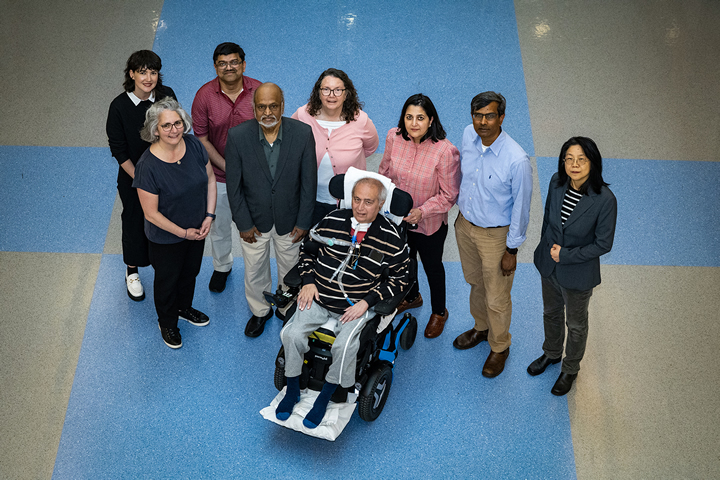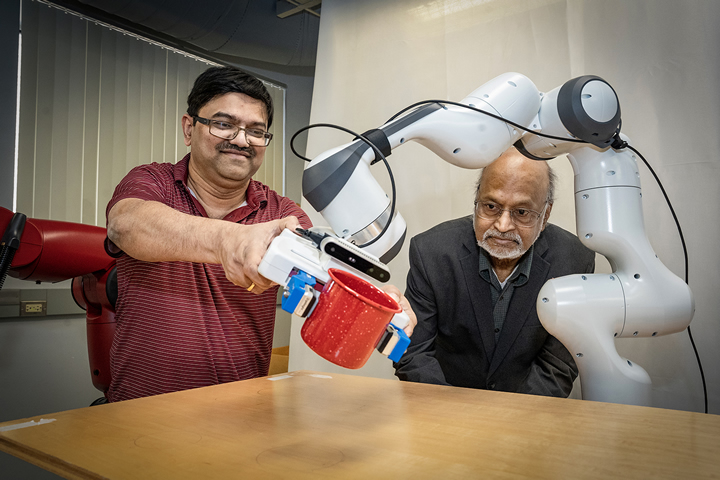On the Horizon: A Robot to Assist ALS Patients

Some members of the CART research team assembled in the New Computer Sciences Building. Vibha Mullick, and her husband, ALS patient Anuraag Mullick, in the center. Back row, from left: Clare Whitney, Nilanjan Chakraborty, Theresa Imperato, C.R. Ramakrishnan, and Wei Zhu. Front row, from left, are Maria Milazzo and I.V. Ramakrishnan. Credit: John Griffin
The debilitating disease of amyotrophic lateral sclerosis (ALS) leads to loss of mobility and an inability for patients to complete even basic tasks like lifting their arms, eating, or moving their hands. This brings great stress to patients and their caregivers. A team of Stony Brook University researchers is aiming to alleviate the many difficulties that accompany advancing ALS by using computer and artificial intelligence (AI) technologies, mechanical engineering, and consultation by medical experts to create a Caregiving Robot Assistant (CART) for ALS patients and their caregivers.
The project is supported by three-year, $1.5 million grant from the U.S. Army. It is led by I.V. Ramakrishnan, PhD, Professor of Computer Science and an Associate Dean in the College of Engineering and Applied Sciences at Stony Brook University. The multidisciplinary research includes faculty in Computer Science, Engineering, Nursing, the Renaissance School of Medicine (RSOM), and clinical and support staff from the Christopher Pendergast ALS Center of Excellence in the Neurosciences Institute at Stony Brook Medicine.
“We are in the process now of developing CART into a usable prototype for ALS patients and their caregivers,” says Ramakrishnan. “The technical innovation of CART is in the development of an algorithmic approach to manipulation planning based on the screw geometry of motion along with an approach to what we call ‘self-evaluation,’ where the robot evaluates its competence in performing a task and actually prompts a caregiver to provide additional demonstrations,” he explains, noting that this work is led by Nilanjan Chakraborty, PhD, a Professor and roboticist in the Department of Mechanical Engineering.
The AI technology built within CART enables it to mimic how to do a task using the movements a caregiver provides manually as guidance. Crucially, CART will learn from only a few examples in an interactive manner by actively prompting the caregiver for demonstration examples as the robot needs, and thereby not overly burdening the caregiver. For example, a caregiver would provide how CART should move its robotic arms to pick up a spoon, and angle it exactly toward the patient’s mouth, or provide the steps to move a cup and empty it.
Additionally, because ALS patients’ needs change, and can change quickly, the program enables caregivers to easily “train” CART to perform tasks differently, or add new tasks as well. This adaptability aspect of CART is central to the project with actual patient use.

Demonstrating one of the CART designs in a Stony Brook engineering lab are I.V. Ramakrishnan and Nilanjan Chakraborty, who shows how to move the robot’s arm essentially “training” it to hold a cup and move its arm to a designated location. Credit: John Griffin
Patient Testing
Vibha Mullick, a Senior Web and Database Analyst in Computer Science and a team member on the project, will provide crucial consultation to the interdisciplinary group about CART in the areas of design, user-friendly aspect of CART, and functionality.
Her husband of 38 years, Anuraag Mullick, 64, has lived with ALS since 2016. He is treated at Stony Brook Medicine’s Chris Pendergast ALS Center of Excellence. Anuraag now has severe motor disability, limited range with his arms and hands, difficulty swallowing and speaking, and respiratory problems. Vibha is his primary caregiver. Together they will test CART as it is programmed and re-programmed and further developed into a prototype.
“Coping with grief, fear, frustration and the uncertainties that come with advancing ALS is an ongoing challenge,” says Vibha. “We are hoping that by providing insight into just how effective CART can be for my husband as a patient and me as a caregiver helps to ensure this new technology bridges the gap between technological innovation and the lived experience of ALS caregiving. And we hope it will be great tool to improving the quality of life for Anuraag, and other ALS patients.”
Anuraag had a long and successful career as a hotel manager and owner before his ALS diagnosis. He will experience and test CART with Vibha when it is further developed in the lab, and he may be able to use CART when at home.
Clare Whitney, PhD, and Maria Milazzo, PhD, in the School of Nursing will coordinate with Vibha to conduct the patient user aspect of the study. Simona Treidler, MD, of the Department of Neurology, along with Theresa Imperato, RN, of the ALS Center of Excellence, will recruit other ALS patients to try using CART as they assess patients’ disease stages and their needs.
Vibha hopes the team is able to push the technology to the point where integrating robots into physiotherapy is a routine program to assist Anuraag and other ALS patients with range of motion exercises.
While CART will be tested initially for ALS patients, it is ultimately being designed for any patient with acute or chronic locomotor disabilities.
The investigators believe that the ease with which CART can be trained, operated, and adapted to evolving patient needs will eventually “usher in a new generation of assistive robots to provide reliable, round-the-clock physical assistance to people with severe locomotor disability and make caregiving much less burdensome.”
Other research collaborators include C.R. Ramakrishnan in Computer Science, who leads the inferencing component; and Wei Zhu in Applied Mathematics and Statistics, the biostatistician for the project.
Comments (0)
This post does not have any comments. Be the first to leave a comment below.
Featured Product

